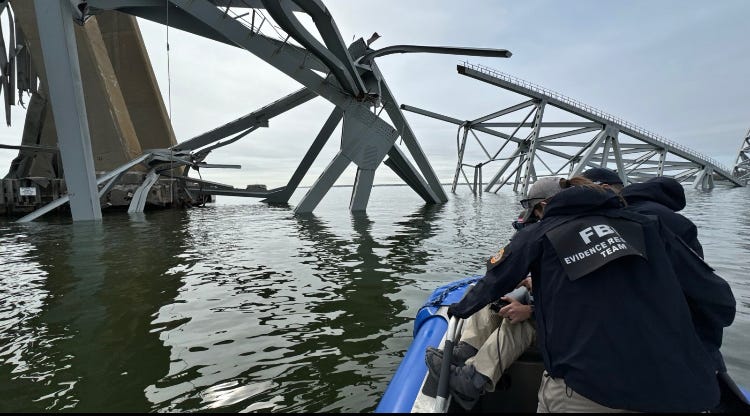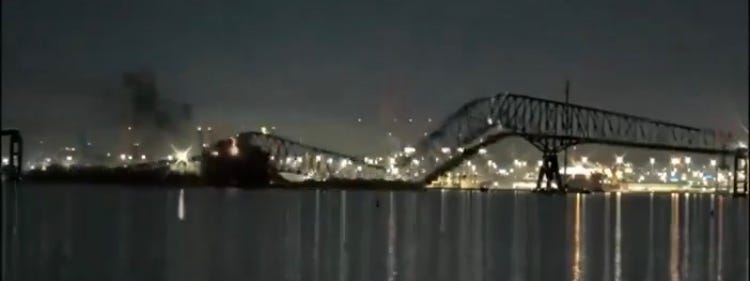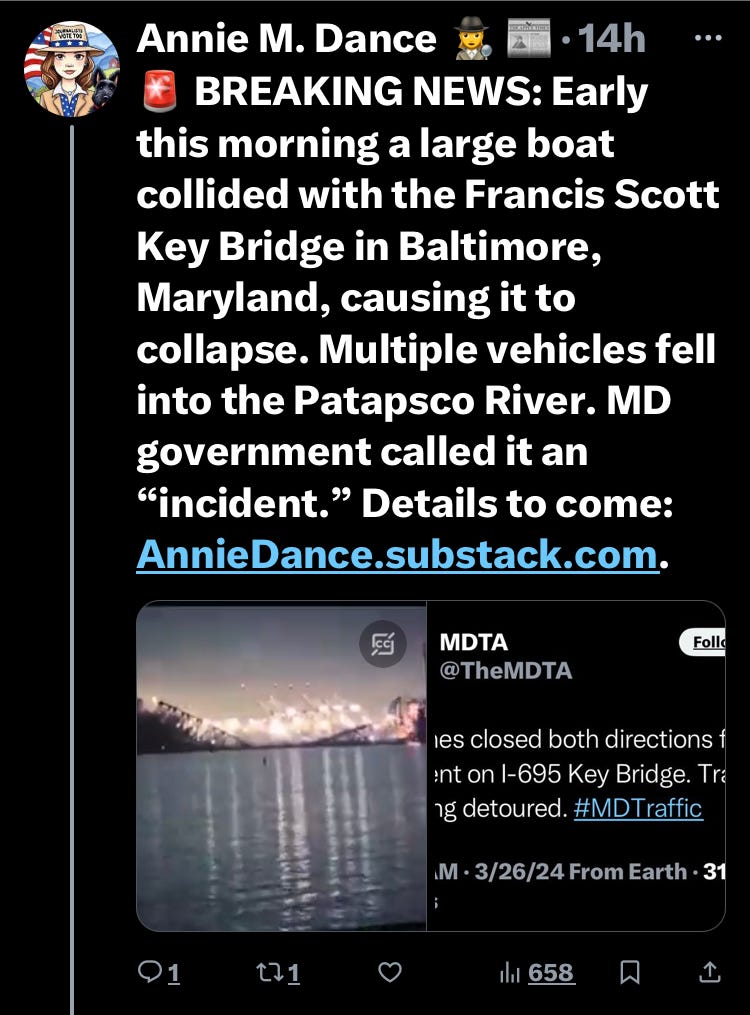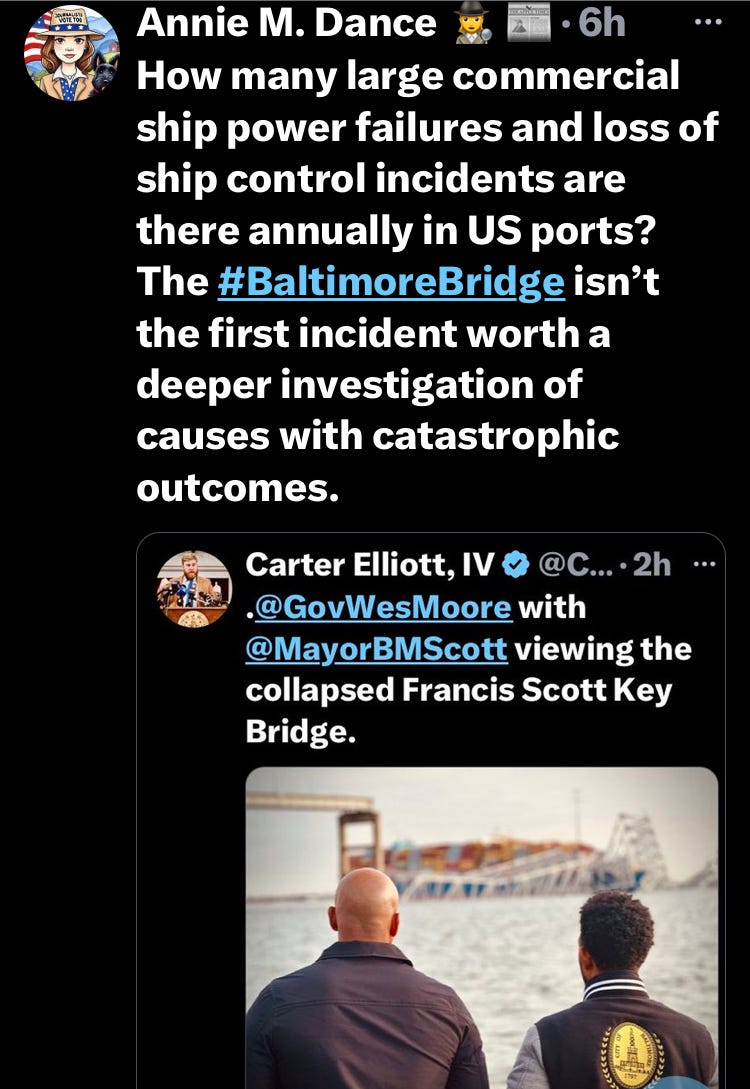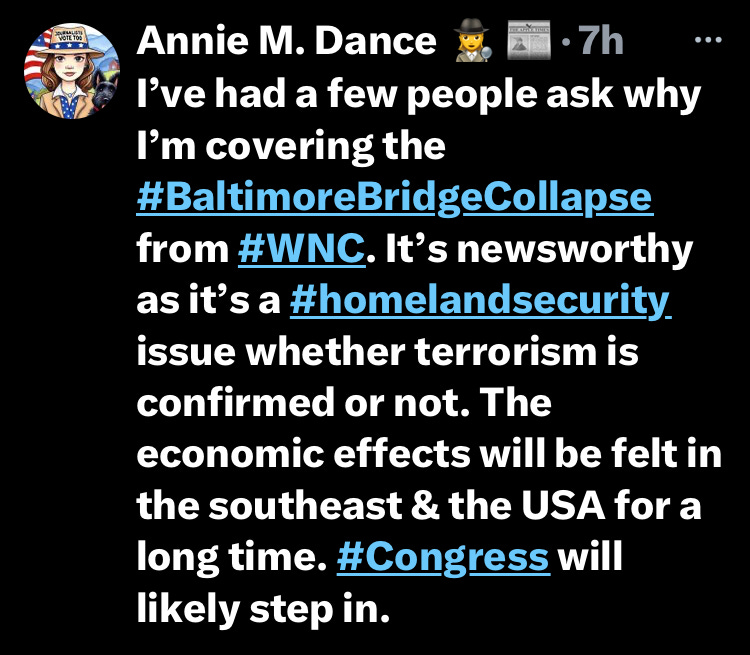FBI: 'No ties to terrorism' in Baltimore bridge collapse, investigation is ongoing
Terrorism among key infrastructure is always a concern, police sources told me.
If you’ve been following the news today, you may already know the Francis Scott Key Bridge in Baltimore, Maryland partially collapsed due to a container ship hitting a support beam. The ship’s warning enabled authorities to limit vehicle traffic on the span. Plus, the accident occurred at 1:30 a.m., long before the busy morning rush. The bridge carried an estimated 30,800 vehicles a day on average in 2019.
I was one of the first journalists to report about the incident on X (formerly Twitter), early this morning. Please follow me there if you haven’t already, it’s where I usually post breaking news (and follow up with a longer form piece here.)
There is no specific and credible information to suggest any ties to terrorism at this time, but the investigation is ongoing, according to the FBI. “Our hearts go out to everyone impacted by this tragedy, especially to the victims and their families," FBI Baltimore Special Agent in Charge William J. DelBagno said. "On behalf of the FBI, I would like to say we are with you and with the families involved.”
FBI Baltimore, the Bureau's Critical Incident Response Group (CIRG), the FBI Washington Field Office (WFO), and the FBI Laboratory have deployed the following personnel to assist the Maryland Transportation Authority Police (MTAP) including supervisory special agents, linguists, victim specialists, a public information officer, airport/port liaison special agent, various task force officers, WFO Underwater Search and Evidence Response Team divers and FBI Laboratory Divers, according to a press release. CIRG and WFO are deploying specialized equipment to assist with this incident.
Last June, federal inspectors rated the 47-year-old bridge in fair condition. But the structure did not appear to have pier protection to withstand the crash, experts said, according to the Associated Press.
From 1960 to 2015, there were 35 major bridge collapses worldwide due to ship or barge collisions, with a total of 342 people killed, according to a 2018 report from the World Association for Waterborne Transport Infrastructure. Eighteen of those collapses happened in the United States, the AP reported.
Cops & Congress commentary
I was in NYC on 9/11/01. I worked for the NY State Senate Homeland Security Committee in 2011. I have profound skepticism as an investigative journalist, especially when government officials say there are no ties to terrorism on the same day of the incident. Terrorism involving bridges typically involves attacks aimed at causing significant damage, disruption, or casualties. In my view, all three components happened today. Six people are presumed dead, officials say. Don’t think it is terrorism? Here are some aspects to consider:
Targets: Bridges are often targeted due to their symbolic significance, economic importance, and potential for mass casualties. High-profile bridges in major cities or those with strategic significance may be more vulnerable to terrorist attacks.
Methods: Terrorists may employ various methods to attack bridges, including explosive devices, vehicle ramming attacks, or sabotage. Explosives planted on or under the bridge hijacked vehicles driven into pedestrian areas, or coordinated cyberattacks targeting bridge systems are some examples.
Impact: Attacks on bridges can result in widespread destruction, loss of life, disruption of transportation networks, and economic damage. The collapse or severe damage to a major bridge can paralyze traffic, impede emergency response efforts, and undermine public confidence in infrastructure security.
Prevention and Mitigation: Governments and bridge authorities implement security measures such as surveillance cameras, increased police patrols, structural reinforcements, and cybersecurity protocols to prevent and mitigate terrorist threats. Public awareness campaigns, emergency response drills, and collaboration with intelligence agencies also play crucial roles in safeguarding bridges against terrorism.
Overall, terrorism involving bridges poses significant security challenges and requires comprehensive strategies to deter, detect, and respond to potential threats effectively.
Like many other infrastructure assets, bridges are potential targets for terrorist attacks due to their symbolic significance and potential to cause widespread disruption and loss of life. Following the events of September 11, 2001, security measures across critical infrastructure, including bridges, were significantly heightened in the United States. This was in response to the heightened awareness of vulnerabilities to terrorism. Infrastructure security agencies, such as the Department of Homeland Security, work in conjunction with local law enforcement agencies to monitor and protect key bridges and other critical infrastructure from potential terrorist threats.
While specific threats against bridges might not be publicly disclosed, it's safe to assume that security measures are in place to attempt to mitigate potential risks. These measures may include surveillance, increased patrols, structural hardening, and coordination with intelligence agencies to assess and address any credible threats.
As one of the leading ports on the East Coast, Baltimore handles a diverse range of cargo including containers, automobiles, bulk commodities, and refrigerated goods. Its modern facilities, efficient operations, and extensive transportation network (including rail and road connections) make it an attractive choice for businesses engaged in international trade. The port serves as a crucial link in global supply chains, facilitating the movement of goods between the United States and markets worldwide. The collapse will almost surely create a logistical nightmare for months, if not years, in the region, shutting down ship traffic at the Port of Baltimore, a major shipping hub.
Maryland and North Carolina are both part of the Fourth Circuit Court of Appeals, which is one of the thirteen federal appellate courts in the United States. It has jurisdiction over federal cases arising from the states of Maryland, North Carolina, South Carolina, Virginia, and West Virginia, as well as the District of Columbia. The court is based in Richmond, Virginia. The Fourth Circuit hears appeals from federal district courts within its jurisdiction, covering a wide range of legal issues including civil and criminal matters, administrative agency decisions, and constitutional issues.
Rutherford County, NC, and the Francis Scott Key Bridge in Baltimore may seem like disparate entities at first glance, but there are some similarities worth noting:
Historical Significance: Both have historical significance in their respective regions. Rutherford County, NC, has a rich history dating back to colonial times, with notable events during the American Revolutionary War and the Civil War. The Francis Scott Key Bridge in Baltimore is named after the author of "The Star-Spangled Banner," which was inspired by the defense of Baltimore during the War of 1812.
Transportation Infrastructure: Both Rutherford County and the Francis Scott Key Bridge play crucial roles in transportation. Rutherford County is a hub for roadways and highways connecting various parts of North Carolina and neighboring states. Similarly, the Francis Scott Key Bridge is a vital component of Baltimore's transportation network, providing a crucial link across the Patapsco River for commuters and cargo.
Natural Beauty: While Rutherford County boasts scenic landscapes, including portions of the Blue Ridge Mountains and the South Mountains, the Francis Scott Key Bridge offers stunning views of the Baltimore skyline and the harbor.
Community Identity: Both Rutherford County and the Francis Scott Key Bridge contribute to the identity and sense of community for residents in their respective areas. They are landmarks that locals often associate with home and take pride in.
Despite their geographical and functional differences, these similarities highlight how both Rutherford County and the Francis Scott Key Bridge hold significance within their communities and contribute to their cultural fabric.
Cops & Congress by Annie Dance is a service journalism newsletter, focusing on police, policy, and public records in the Lake Lure area of western NC and beyond. This article is free to read due to generous support from founding member subscribers.
Thank You
📰 You, the subscribers and donors make this independent, community-supported, public-service journalism possible.
☕️ ⛽️ Virtually buy me a coffee or a gallon of gas to help me inform you by covering important issues. Donate here. For further inquiries, including tips, suggestions, in-kind support, or sponsorships, email CopsandCongress@gmail.com.
Follow me on X (Twitter), Facebook, Linkedin, Instagram, TikTok, and YouTube.
Learn more about this newsletter and my background.
(Free subscribers: Upgrade to paid to leave a comment below and don’t miss out on exclusive content.)


